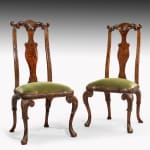Pair of George I Carved Walnut Side Chairs
115.5 x 55 x 51 cm
Further images
-
(View a larger image of thumbnail 1
)

-
(View a larger image of thumbnail 2
)

-
(View a larger image of thumbnail 3
)

-
(View a larger image of thumbnail 4
)

-
(View a larger image of thumbnail 5
)

-
(View a larger image of thumbnail 6
)

-
(View a larger image of thumbnail 7
)

-
(View a larger image of thumbnail 8
)

-
(View a larger image of thumbnail 9
)

-
(View a larger image of thumbnail 10
)

-
(View a larger image of thumbnail 11
)

-
(View a larger image of thumbnail 12
)

-
(View a larger image of thumbnail 13
)

Provenance
Possibly commissioned by Sir Thomas Lyttelton, 4th Baronet (1686-1751) for Arley Hall (later Arley Castle).Part of a set of at least twelve chairs. Six chairs of the same model were supplied to the Lyttelton family at Arley Hall (later Arley Castle), in Worcestershire, in a sale catalogue dating from 1852. It is interesting to note that the shell carved on each crest of the offered chairs is very similar to the scallop shell which forms part of the coat of arms of the Lyttelton family.Acquired from Mallett and Son Exhibition of Old English Furniture, Needlework, Silver, Porcelains and Objects of Art, 40 New Bond Street, lot 146, in 1936 and thence by descent.
With a narrow banister back, combining parallel rear posts with a baluster splat. Each with a serpentine scrolled acanthus carved toprail centred by a stippled stylised shell cresting incorporating six shallow relief-carved rosette and husk pendant straps, above a vase shaped splat with interlacing line-inlay, flanked by shallow relief carved foliate strapwork stiles, on foliate scrolled, scallop shell and acanthus clasped scrolled cabriole front legs terminating in leaf wrapped front feet, with cabriole back legs.
Adam Bowett illustrates a very similar walnut chair with modern upholstery in ‘English Furniture 1660 – 1714: From Charles II to Queen Anne’ (Antique Collectors’ Club, 2002), p.163, plate 4:36. This chair is one of the set which were formerly at Arley Castle. Bowett states that: ‘A number of chairs of this design are known, all apparently originating from a set of fourteen or sixteen possibly made for the Lyttelton family. It is an extraordinary mixture of ‘Indian’ and baroque styles, suggesting the maker was able to draw on a wide range of sources to create his design. The shallow-relief Berainesque carving is more commonly associated with gilt furniture.’ He comments that: ‘The frame is enriched with low relief Berainesque carving in the manner of contemporary gilt-gesso work, while the legs are superbly modelled with leafy cartouches to the knees and water-leaf feet. The carving is reminiscent of contemporary Chinese chairs made for the English market, and this may be a deliberate imitation, endowing an otherwise conventional chair with exoticism and mystery.’ (Adam Bowett, ‘English Furniture 1660 – 1714: From Charles II to Queen Anne’ (Antique Collectors’ Club, 2002), pp.162-3).
Bowett illustrates another of the chairs from the set formerly at Arley Castle, Kidderminster, Worcestershire in ‘100 British Chairs’. This chair is one of a pair, which Bowett here describes as being from a set of at least twelve, and is upholstered with a needlework depicting the crest of the Lyttleton family, who lived at Arley Castle (see Adam Bowett, ‘100 British Chairs’ (Crab Tree Farm, 2015), plate 22, p.40.
Another chair from the same suite, from Mallett and Son and dated c.1715, is illustrated in Ralph Edwards’ ‘The Dictionary of English Furniture: Volume One’ (Antique Collectors’ Club, 1983), fig.88, p.255. He describes the chair as a ‘rare variant’ from the fashionable types, having elements such as ‘cabriole legs carved with foliage on knee and toe’ and ‘the moulded seat rail decorated with crossed branches’ which depart from the familiar pattern (p.254) and make these chairs more difficult to date. This same chair is illustrated in Nicholas Grindley’s “The Bended Back Chair” (London: Barling of Mount Street, 1990). Grindley states that this ‘is a very unusual chair, originally from a set of twelve with tapering square section stiles carved with flat foliate strapwork on a punched ground interspersed with leaves and flowerheads. The elaborately carved cresting rail has a central shell like motif similarly carved with leaf scrolls ‘falling’ over the toprail and curling upwards at the ends. The splat is decorated with flat strapwork. Both the seat rail and the decoration at the knee is reserved on this punched ground. The leaf covering the pad feet at the front is a most unusual motif’. The description concludes: ‘A set of ten and a single chair are in private collections in the United States.’













